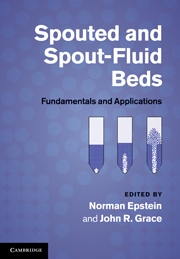Book contents
- Frontmatter
- Contents
- Contributors
- Preface
- Common nomenclature
- 1 Introduction
- 2 Initiation of spouting
- 3 Empirical and analytical hydrodynamics
- 4 Computational fluid dynamic modeling of spouted beds
- 5 Conical spouted beds
- 6 Hydrodynamics of spout-fluid beds
- 7 Spouted and spout-fluid beds with draft tubes
- 8 Particle mixing and segregation
- 9 Heat and mass transfer
- 10 Powder–particle spouted beds
- 11 Drying of particulate solids
- 12 Drying of solutions, slurries, and pastes
- 13 Granulation and particle coating
- 14 The Wurster coater
- 15 Gasification, pyrolysis, and combustion
- 16 Spouted bed electrochemical reactors
- 17 Scaleup, slot-rectangular, and multiple spouting
- 18 Mechanical spouting
- 19 Catalytic reactors and their modeling
- 20 Liquid and liquid–gas spouting of solids
- Index
- References
17 - Scaleup, slot-rectangular, and multiple spouting
Published online by Cambridge University Press: 04 February 2011
- Frontmatter
- Contents
- Contributors
- Preface
- Common nomenclature
- 1 Introduction
- 2 Initiation of spouting
- 3 Empirical and analytical hydrodynamics
- 4 Computational fluid dynamic modeling of spouted beds
- 5 Conical spouted beds
- 6 Hydrodynamics of spout-fluid beds
- 7 Spouted and spout-fluid beds with draft tubes
- 8 Particle mixing and segregation
- 9 Heat and mass transfer
- 10 Powder–particle spouted beds
- 11 Drying of particulate solids
- 12 Drying of solutions, slurries, and pastes
- 13 Granulation and particle coating
- 14 The Wurster coater
- 15 Gasification, pyrolysis, and combustion
- 16 Spouted bed electrochemical reactors
- 17 Scaleup, slot-rectangular, and multiple spouting
- 18 Mechanical spouting
- 19 Catalytic reactors and their modeling
- 20 Liquid and liquid–gas spouting of solids
- Index
- References
Summary
Introduction
Scaleup of test results from smaller to larger equipment is an important aspect in the design and operation of spouted bed units for physical and chemical processes of practical importance. A key need is the ability to use data obtained on smaller units in the design of full-scale equipment. Similar considerations pertain to the application of results obtained at atmospheric pressure and room temperature to columns to be operated at elevated pressures and/or temperatures. Despite the inclusion of words such as “scaleup” and “scaling” in the titles of a number of articles dealing with spouted beds, there are no established procedures for scaleup and considerable uncertainty about how best to achieve it. The question of the maximum practical size of spouted beds is also unresolved. As noted with reference to fluidized beds, scaleup is “not an exact science, but remains the province of that mixture of mathematics, witchcraft, history and common sense which we call engineering.”
This chapter considers a number of interrelated questions and issues:
Is there a maximum practical size of spouted beds, and if so, what is it?
What is the effect of column diameter on spouting behavior? What are the effects of pressure and temperature?
Can one use small-scale results reliably to predict spouting behavior in larger columns? In particular, can one use dimensional similitude to scale up (or scale down) hydrodynamics and other experimental results obtained in equipment of a given size to predict with confidence behavior and performance of a unit of a different size but similar geometry?
[…]
- Type
- Chapter
- Information
- Spouted and Spout-Fluid BedsFundamentals and Applications, pp. 283 - 296Publisher: Cambridge University PressPrint publication year: 2010
References
- 1
- Cited by



